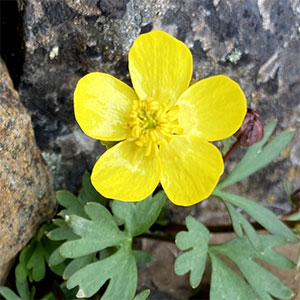Ranunculus basalticus
Ranunculus californicus
basalt buttercup
California buttercup, common buttercup
never tuberous.
erect to prostrate, never rooting nodally, hirsute, strigose, or glabrous, base not bulbous.
broadly ovate or cordate in outline, 3-lobed or -parted to 3-foliolate, 1.8-5.8 × 2.3-7.6 cm, leaflets or segments undivided or 1-2x-lobed or -parted, ultimate segments linear to orbiculate, margins toothed, crenate, or entire, apex acute to rounded.
receptacle glabrous or rarely hispid;
sepals reflexed 2-3 mm above base, 4-8 × 2-4 mm, pilose;
petals 9-17, yellow, (6-)7-14 × 2-6 mm.
globose or hemispheric, 3-7 × 4-9 mm;
achenes 1.8-3.2 × 1.4-3.2 mm, glabrous, rarely hispid, margin forming narrow rib 0.1-0.2 mm wide;
beak persistent, lanceolate, curved, 0.2-0.8 mm.
Ranunculus basalticus
Ranunculus californicus
Varieties 2 (2 in the flora).
In addition to the range given, localized populations of Ranunculus californicus have been reported recently from a few islands in the vicinity of Victoria (British Columbia and Washington) (M. F. Denton 1978; T. C. Brayshaw 1989). Those populations are small and introgress freely with R. occidentalis wherever they come together. Denton referred her specimens to R. californicus var. cuneatus; Brayshaw reported both varieties from the same small populations, but his data are consistent with populations of R. californicus var. cuneatus that are introgressing extensively with R. occidentalis. Although both Denton and Brayshaw treat R. californicus as a native species in that region, several reasons support the belief that it is introduced there. No reports of R. californicus in the area occur prior to 1978, although the area is quite well collected (especially Victoria, B. C. and the San Juan Islands, Washington); a long history of extensive marine trade between Victoria and San Francisco has resulted in the introduction of a number of other California species to the area; and for scattered small populations of R. californicus to have persisted for long periods in the face of free introgression from R. occidentalis seems unlikely. Given the small population size and the introgression from R. occidentalis, it is questionable whether R. californicus can persist in the area.
(Discussion copyrighted by Flora of North America; reprinted with permission.)
1. Stems erect to decumbent, hirsute or glabrous; ultimate segments of basal leaf blades acute to rounded-acute at apex. | var. californicus |
1. Stems prostrate, strigose; ultimate segments of basal leaf blades rounded to obtuse at apex. | var. cuneatus |
- Local floras:
WA
- Local Web sites:
Flora NW,
PNW Herbaria
WildflowerSearch
iNaturalist (observations)
- LBJ Wildflower Center
- SEINet
- Plants of the World Online
- Encyclopedia of Life
- Wikipedia
- Google Image Search
- Local floras:
BC,
CA,
OR,
WA
- Local Web sites:
CalFlora,
CalPhotos,
Flora NW,
PNW Herbaria
WildflowerSearch
iNaturalist (observations)
USDA Plants Database
- LBJ Wildflower Center
- SEINet
- Plants of the World Online
- Encyclopedia of Life
- Wikipedia
- Google Image Search
